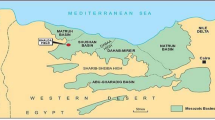Abstract
In the Jemmel–Zéramdine region, the combined analysis of petroleum well data, seismic reflection profiles, and gravity data show the presence of the Zéramdine fault corridor, which was activated in the Neogene period. Both tectonic activity and fluvio-deltaic sedimentation are the origin of the lithologic and hydrodynamic heterogeneities. Thus, the Zéramdine fault corridor constitutes a limit between two hydraulic systems formed by Miocene sandy reservoir layers. These reservoirs have not been exploited yet and could be new water resources which can extremely benefit the region; only the upper one is exploited in the Jemmel–Bembla and Zéramdine–Béni Hassen deep aquifers. The wire line logging, seismic reflection, and gravity interpretations show the distribution of the Miocene layers which formed the Sahel Miocene deep aquifers. The Zéramdine fault corridor leads to a spatial variability in number, distribution, depths, and thicknesses of these reservoir layers. In the northern part of the Zéramdine fault corridor, seven layers were highlighted; their thicknesses range between 15 and 105 m. However, in the southern part, only four strata were deposited: their thicknesses vary between 45 and 53 m. The total porosity of the studied aquifers is about 30%.







Similar content being viewed by others
References
Bédir M (1988) Géodynamique des bassins sédimentaires du Sahel de Mahdia (Tunisie orientale) depuis l’Aptien à l’actuel. Sismos-tratigraphie, sismo-tectonique et structurale. Répercussions pétrolières, hydrologiques et sismiques, 9. Ph.D. thesis, Université de Tunis, Revue des Sciences de la Terre, Tunisia. p 242
Bédir M, Zargouni F, Tlig S, Bobier C (1992) Subsurface geodynamics and petroleum geology of transform margin basins in the Sahel of Mahdia and El Jem (eastern Tunisia). AAPG Bull 76(9):1417–1442
Bédir M, Tlig S, Bobier C, Zargouni F, Aïssaoui N (1996) Sequence stratigraphy, basin dynamics and petroleum geology of Miocene from the eastern Tunisia. Am Assoc Petrol Geol Bull 80(1):63–81
Beni-Akhy R (1998) Etude des impacts anthropiques sur les eaux souterraines du Sahel oriental tunisien: caractérisation hydrogéologique, modélisation mathématique et cartographie de la vulnérabilité environnementale. Ph.D. thesis, University of Tunis II. p 377
Bouri S, Ben Dhia H (2010) A thirty-year artificial recharge experiment in a coastal aquifer in an arid zone: the Teboulba aquifer system (Tunisian Sahel). Comptes Rendus Geosciences 342(1):60–74
Buness H et al (1989) The EGT'85 seismic experiment in Tunisia: a reconnaissance of the deep structures. In: Freeman R, Muller S (eds) Sixth Workshop on the European Geotraverse project, data compilations and synoptic interpretation. European Science Foundation, Strasbourg, pp 197–210
Burollet PF (1956) Contribution à l’étude stratigraphie de la Tunisie centrale. Ann Mines Géol 18:350, Tunis
DGRE (2002) Annuaire de l’exploitation des nappes profondes. Technical report, Direction Générale des Ressources en Eau, Tunis
Gaaloul N (1995) Les environnements siliciclastiques du Néogène du Sahel de la Tunisie: palynologie et biosédimentologie. Ph.D. thesis, University of Tunis II, Tunisia. p 256
Gabtni H (2005) Apport de la gravimétrie à l’étude des structures profondes du Sahel de Tunisie (cas de la région de Kairouan-Sousse-Monastir). Gravity contribution on the deep structure study of the Tunisian Sahel domain (a Kairouan-Sousse-Monastir area case). C.R.A.S. Géosciences 337:1409–1414
Gabtni H, Chulli Zenatti B, Jallouli C, Mickus KL, Bédir M (2010) The crustal structure of the Sahel Basin (eastern Tunisia) determined from gravity and geothermal gradients: implications for petroleum exploration. Arab J Geosci. doi:10.1007/s12517-010-0151-0
Hubert C (1968) Etude hydrogéologique du Vindobonien dans la région de Zéramdine-Béni Hassen. Technical report, DGRE, Tunis. p 53
Kammoun Y (1981) Etude néotectonique dans la région de Monastir–Mahdia (Tunisie orientale). Ph.D. thesis, Acad. Paris., University of Paris IX, Centre Orsay. p 175
Lachaal F (2006) Etude hydrogéologique et modélisation de la nappe profonde miocène de Zéramedine-Beni Hassen dans le Sahel de la Tunisie. Master’s thesis, University of Carthage, Institut National Agronomique de Tunisie. p 92
Lachaal F, Bédir M, Tarhouni J, Leduc C (2010) Hydrodynamic and hydrochemical changes affecting groundwater in a semi-arid region: the deep Miocene aquifers of the Tunisian Sahel (central east Tunisia). IAHS Publ 340:374–381
Mannaï-Tayech B (2009) The lithostratigraphy of Miocene series from Tunisia, revisited. J Afr Earth Sci 54:53–61
Morelli (1976) Modern standards for gravity surveys. Geophysics 41:1051
Plouff D (1977) Preliminary documentation for a FORTRAN program to compute gravity terrain corrections based on topography digitized on a geographic grid. US Geological Survey Open-File Report 77-535, Denver, Colorado, USA. p 111
Row LW, Hastings DA, Dunbar PK (1995) TerrainBase: worldwide digital terrain data. US Texas, US. Department of Commerce, National Geophysical Data Center, Boulder, p 163
Acknowledgments
The authors want to thank Pr. Kevin Mickus (Missouri State University, USA); his comments and suggestions have significantly contributed to the improvement of this manuscript.
Author information
Authors and Affiliations
Corresponding author
Rights and permissions
About this article
Cite this article
Lachaal, F., Gabtni, H., Bédir, M. et al. Seismic, gravity, and wire line logging characterization of the Zéramdine fault corridor and its influence in the deep Miocene aquifers distribution (east-central Tunisia). Arab J Geosci 5, 1391–1398 (2012). https://doi.org/10.1007/s12517-011-0298-3
Received:
Accepted:
Published:
Issue Date:
DOI: https://doi.org/10.1007/s12517-011-0298-3




